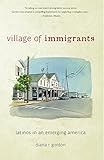Village of Immigrants : Latinos in an Emerging America / Diana R. Gordon.
Material type: TextSeries: Rivergate Regionals CollectionPublisher: New Brunswick, NJ : Rutgers University Press, [2015]Copyright date: ©2015Description: 1 online resource (256 p.)Content type:
TextSeries: Rivergate Regionals CollectionPublisher: New Brunswick, NJ : Rutgers University Press, [2015]Copyright date: ©2015Description: 1 online resource (256 p.)Content type: - 9780813575902
- 9780813575926
- Hispanic Americans -- New York (State) -- Greenport -- Biography
- Hispanic Americans -- New York (State) -- Greenport -- Social conditions
- Immigrants -- New York (State) -- Greenport -- Biography
- Immigrants -- New York (State) -- Greenport -- Social conditions
- Social change -- New York (State) -- Greenport
- Working class -- New York (State) -- Greenport -- Biography
- Working class -- New York (State) -- Greenport -- Social conditions
- SOCIAL SCIENCE / General
- 305.9/069120974721 23
- F129.G714 G67 2015
- F129.G714 G67 2015eb
- online - DeGruyter
- Issued also in print.
| Item type | Current library | Call number | URL | Status | Notes | Barcode | |
|---|---|---|---|---|---|---|---|
 eBook
eBook
|
Biblioteca "Angelicum" Pont. Univ. S.Tommaso d'Aquino Nuvola online | online - DeGruyter (Browse shelf(Opens below)) | Online access | Not for loan (Accesso limitato) | Accesso per gli utenti autorizzati / Access for authorized users | (dgr)9780813575926 |
Browsing Biblioteca "Angelicum" Pont. Univ. S.Tommaso d'Aquino shelves, Shelving location: Nuvola online Close shelf browser (Hides shelf browser)

|

|

|

|

|

|

|
||
| online - DeGruyter New Brunswick, New Jersey : The Decline and Revitalization of Urban America / | online - DeGruyter American Girls and Global Responsibility : A New Relation to the World during the Early Cold War / | online - DeGruyter U.S. Women's History : Untangling the Threads of Sisterhood / | online - DeGruyter Village of Immigrants : Latinos in an Emerging America / | online - DeGruyter Coming of Age in Jewish America : Bar and Bat Mitzvah Reinterpreted / | online - DeGruyter Writing America : Literary Landmarks from Walden Pond to Wounded Knee (A Reader's Companion) / | online - DeGruyter Flickers of Film : Nostalgia in the Time of Digital Cinema / |
Frontmatter -- CONTENTS -- Preface -- PART I. A Village Transformed -- 1. Hola, Greenport -- Profile: Lost and Found -- PART II. Absorbing Immigrants since 1840 -- 2. The European Legacy -- 3. Boom, Bust, and Back Again -- 4. Migration from Within -- 5. Is Demographics Destiny? -- PART III. Classroom Challenges -- 6. Schooling New Citizens -- Profile: Edgar and the Blue Mosque -- PART IV. Settling In -- 7. Housing or Houses? -- Profile: Sofia's Quest -- PART V. Toward Community Health -- 8. Cobbled Care -- Profile: An Accidental Nurse -- PART VI. Dilemmas of Control -- 9. Legal Limbo -- Profile: Deferred and Delivered -- PART VII. Working Lives -- 10. Where There's a Will, There's a Job (or Two) -- Profile: Sacrifice and Success -- PART VIII. What Next? -- Profile: The New American -- 11. A Small-Town Model? -- Notes -- Index -- ABOUT THE AUTHOR
restricted access online access with authorization star
http://purl.org/coar/access_right/c_16ec
Greenport, New York, a village on the North Fork of Long Island, has become an exemplar of a little-noted national trend-immigrants spreading beyond the big coastal cities, driving much of rural population growth nationally. In Village of Immigrants, Diana R. Gordon illustrates how small-town America has been revitalized by the arrival of these immigrants in Greenport, where she lives. Greenport today boasts a population that is one-third Hispanic. Gordon contends that these immigrants have effectively saved the town's economy by taking low-skill jobs, increasing the tax base, filling local schools, and patronizing local businesses. Greenport's seaside beauty still attracts summer tourists, but it is only with the support of the local Latino workforce that elegant restaurants and bed-and-breakfasts are able to serve these visitors. For Gordon the picture is complex, because the wave of immigrants also presents the town with challenges to its services and institutions. Gordon's portraits of local immigrants capture the positive and the negative, with a cast of characters ranging from a Guatemalan mother of three, including one child who is profoundly disabled, to a Colombian house painter with a successful business who cannot become licensed because he remains undocumented. Village of Immigrants weaves together these people's stories, fears, and dreams to reveal an environment plagued by threats of deportation, debts owed to coyotes, low wages, and the other bleak realities that shape the immigrant experience-even in the charming seaport town of Greenport. A timely contribution to the national dialogue on immigration, Gordon's book shows the pivotal role the American small town plays in the ongoing American immigrant story-as well as how this booming population is shaping and reviving rural communities.
Issued also in print.
Mode of access: Internet via World Wide Web.
In English.
Description based on online resource; title from PDF title page (publisher's Web site, viewed 30. Aug 2021)


